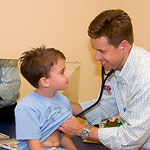What is impetigo and how do you get it?
Impetigo is a superficial bacterial infection of the skin, typically caused by staphylococcal or streptococcal bacteria. Breaks in the skin, by scrape, cut or insect bite, allow the bacteria into the skin leading to the infection. Impetigo develops first as red bumps that progress to cloudy fluid-filled blisters that break open, leaving crusted scabs. The nose and mouth are typical places for the impetigo to begin, but it is very contagious and may spread very quickly with scratching.
Treatment with either oral antibiotics and or special prescription antibacterial ointment will help treat the infection. The rash is contagious until your child has been on antibiotics for 24 hours. Try to discourage your child from touching or picking at the sore. Avoid sharing towels or washcloths with an infected person. Good hand washing is a must. You will need to see your child’s pediatrician to be treated for this condition.
My daughter often gets overheated when playing outside, and I’m worried about her getting a heat injury. What are the warning signs that she is too hot and what are the best ways to keep her from getting overheated?
Heat exhaustion develops after a period of prolonged exercise where there is an excess loss of fluids or salt. It may occur with relatively low air temperature if there is high humidity since you may still sweat excessively. Symptoms include profuse sweating, flushed skin, dry mouth, nausea, vomiting, muscle cramps, generalized weakness as well as irritability or giddiness.
Treatment for heat exhaustion is replacement fluid. Water is adequate if the sporting event is over and the athlete is not vomiting. If the event is ongoing and prolonged, sports drinks which contain sodium and potassium may be better. Occasionally intravenous fluids may be required.
A more extreme form of heat injury is heat stroke. Occurring in high ambient temperature(above 90 degrees F), the body loses its ability to regulate temperature. Patients may have dry, hot red skin with profound lethargy or coma. Treatment involves slowly cooling the body, though fatalities have been reported.
Prevention of heat injuries requires proper conditioning. Overweight and poorly conditioned athletes should gradually begin exercising at least a month before formal practice begins. If moving from a cool climate to a warmer one be sure to allow your body time to acclimate, at least 2 weeks. Once practice begins, ensure your child gets frequent water breaks. Avoid caffeinated or surgary drinks since they increase water loss. If your child begins to have difficulty, move them to a cool area, encourage fluids and get medical help if they fail to improve in a short time.
The information and content on our website should not be used as a substitute for medical treatment or advice from your doctor.




